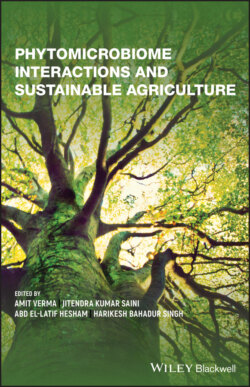Читать книгу Phytomicrobiome Interactions and Sustainable Agriculture - Группа авторов - Страница 14
1.1 Introduction
ОглавлениеRoot exudates are a group of chemical compounds released from plant roots, which contains the ability to alter the activity of soil and microbes below the ground. These chemical compounds are the basis of interaction among root, soil, and microbes in the rhizosphere and also assist in root colonization. Such interaction assists in development‐ and defense‐related activity in plants through enhancing the nutritional availability and suppressing disease occurrences by the alleviation of various stress factors. Root exudates pave the way for communication within the rhizosphere around plant roots, play a pivotal role in the soil system, and create phytomicrobiomes. Generally, plant root exudate consists of 10–40% carbon, primary and secondary metabolites, mucilage, protein, strigolactones, phytohormone, steroids, terpenoids, fatty acids, and nucleotide derivatives, which act as modifiers of rhizospheric soil (Figure 1.1).
Moreover, different parts of the root release different chemical compounds into the soil, such as meristem, the root elongation zone exudes asparagine and threonine, the root hair zone releases various hydrophobic and hydrophilic amino acids, including phenylalanine, leucine, valine, and glutamic acid, aspartic acid excretes from all parts of the root zone, and the root tip secretes mucilage (Badri and Vivanco 2009). Root exudates characteristics and amounts get changed according to plant genotype, age, biotic, and abiotic stress state, health and disease conditions of the plant, the surface area of the root system, and root architecture (Badri and Vivanco 2009). Apart from the plant characteristics, the environmental factors also show an impact on the root exudation mechanism and exudate constituents (Canarini et al. 2019). Thus, understanding the mechanism of root exudation, and factors affecting it, is of prime importance to support environmentally sustainable agriculture and to alleviate the large use of agricultural chemicals that create biosphere contaminations.
Interaction of root exudates and microbes can change the face of the soil, and plants flourish under such conditions, which combats the ill effects of various environmental factors. Thus, root exudation directly effects plant development, which is beneficial to humans and the environment. It is well established that these interactions can promote the growth and productivity of plants, suppress plant disease, increase immunity and the defense of plants, increase nutrient availability and utilization of plants, and enable better coping mechanisms in stress conditions (Bais et al. 2006). Exudation and its interaction with microbes produces a great impact on soil fertility, which may replace the chemical fertilizer applications and pave a way toward eco‐friendly cultivation traditions. It is a well‐established fact that a link exists between the root exudate metabolites and the rhizosphere recruitment of different microbial communities (Schulz‐Bohm et al. 2018; Sugiyama 2019). Apart from interaction studies, root exudates research is at a culminating point with the development of aptamers specifically for root exudates, which can be utilized for development in a fertilizer system (Emily et al. 2013).
Figure 1.1 Classification of root exudates compounds: various compounds are found in the root exudation, which belongs to wide array of biochemical classes.
Root exudates exploration revealed the high diversity of chemicals in plant root exudates. Exudation profiling revealed the presence of chemical compounds, and explains the function of concerning chemical in the soil ecosystem and their effects on plant systems. Few technologies, such as NMR and MS, narrate the structural characters of exudate compounds for clearer observations and assist in unravelling the properties of these compounds that are present in root exudates (Verma et al. 2018). Thus, these studies are directed to the chemical synthesis of those compounds, which can be further utilized for conditioning the soil for particular crop cultivation and for paving a way toward “rhizosphere engineering” (Bais et al. 2006). Root exudates profiling may prove to be the strongest technique for elaborating on the root role and overcomes the plant‐ and soil‐ related issues that hinders crop productivity and sustainable agriculture.
